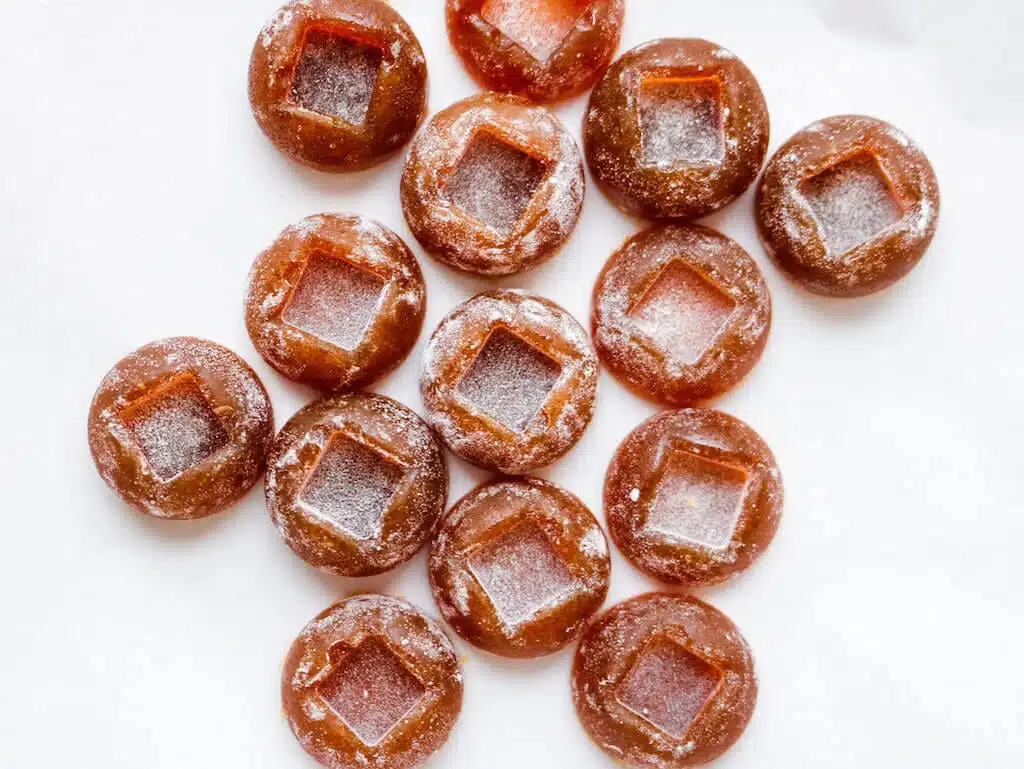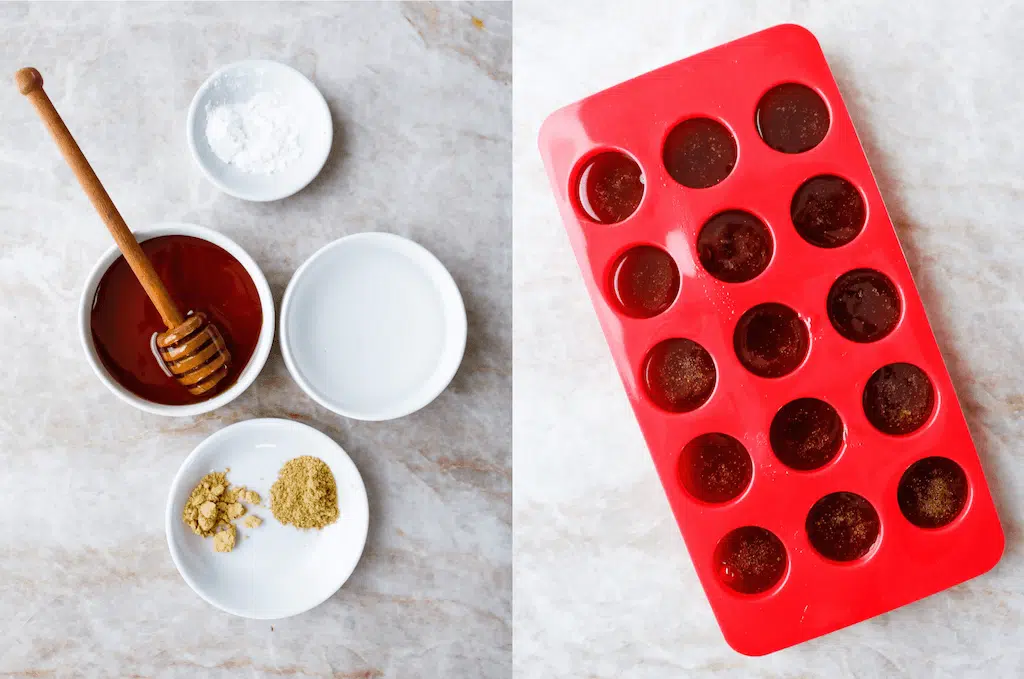
These melt-in-your-mouth digestive pastilles will help ease belly woes and discomfort with soothing ingredients like honey, fennel, and ginger.
Have you ever tried a pastille? It’s a thick candy-like lozenge that can be chewy or solid. They’re used for a wide range of natural healing preparations, from soothing sore throats to aiding in digestion.
Melting one of these orange digestive pastilles in your mouth will help begin the breakdown of carbohydrates. As the pastille melts and works it’s way down the digestive tract, it aids in the increase of enzymes that break down proteins and fats. This is beneficial especially for people who lack these enzymes.
After you remove the pastilles from their molds, roll them in a combination of arrowroot powder and a touch of sea salt. The sea salt helps to increase saliva production. Arrowroot powder helps to keep the pastilles from sticking.
Fennel to the Rescue
Fennel comes in many forms – from the raw bulb with fronds used in salads and soups, to its seed often found whole in Italian sausage. In this preparation, I use ground fennel for its ability to easily dissolve, making it ideal for pastilles. The flavor of ground fennel is bitter with sweet anise-licorice aroma.
The Health Benefits of Fennel
- Fennel contains compounds that help ease digestive ailments associated with stomach upset. Fennel helps the body release gastric enzymes relieving bloating and gas. This is due in part to the seed’s bitter nature that increases bile secretion, important for the breakdown of fats.
- Fennel contains phenols and flavonoids; antioxidants that help protect against oxidative stress.
- Antiviral and anti-microbial properties help support the body’s natural defenses against infection and viruses.
- Fennel is a natural expectorant (an ingredient that helps loosen mucus so that you can cough it up) for respiratory ailments.
Honey for Digestion
Honey not only adds a soothing texture and base for pastilles, but also contains its own digestive benefits like improving gut microflora. Honey acts as a prebiotic feeding good bacteria for a balanced digestive system.
The Health Benefits of Ginger
- Ginger stimulates bile secretion as well as saliva production, both crucial components of digestion.
- Ginger is used to curb nausea and symptoms of an upset stomach.
Tips
- If you can’t find ground fennel, whole seeds can be ground in a spice grinder into a powder.
- Make sure your saucepan is deep enough to accommodate the foam/bubbles that will form in the pan.
- Keep a watchful eye on your candy thermometer and don’t allow the mixture to heat over 300ºF or it will burn.
Candy thermometer
BPA-free silicone candy mold (5 milliliters each cavity or about 1 teaspoon)
- ½ cup honey
- 1 cup filtered water
- 1 ½ teaspoons ground fennel
- 1 teaspoon ground ginger
- 2 teaspoons arrowroot powder
- ⅛ teaspoons sea salt
- Combine water and honey in a medium saucepan over medium-high heat and bring to a rapid boil.
- Stir in fennel and ginger. Insert a candy thermometer and bring temperature to 300ºF. Mixture will foam abundantly as it gets closer to temperature and the color will deepen.
- Quickly but carefully pour mixture into 15 cavities. Set in a dry, cool spot to set for 2-3 hours.
- Gently remove pastilles from silicone molds and roll in arrowroot flour and sea salt in a bowl. Use a strainer to remove excess flour.
To give these digestive pastilles some extra immune-boosting oomph, I recommend trying B. Powered Honey by Beekeeper’s Naturals. Unlike most honeys, B. Powered has a therapeutic blend of royal jelly (what the queen bee eats), bee pollen, propolis, and raw honey.
You can go here to get my favorite B. Powered Honey and Hormones Balance readers can use HORMONEGIFT15 to get 15% off.
Resources
Badgujar, Shamkant B, et al. “Foeniculum Vulgare Mill: a Review of Its Botany, Phytochemistry, Pharmacology, Contemporary Application, and Toxicology.” BioMed Research International, Hindawi Publishing Corporation, 2014.
Portincasa, Piero, et al. “Curcumin and Fennel Essential Oil Improve Symptoms and Quality of Life in Patients with Irritable Bowel Syndrome.” Journal of Gastrointestinal and Liver Diseases : JGLD, U.S. National Library of Medicine, June 2016.
Nikkhah Bodagh, Mehrnaz, et al. “Ginger in Gastrointestinal Disorders: A Systematic Review of Clinical Trials.” Food Science & Nutrition, John Wiley and Sons Inc., 5 Nov. 2018.
Ezz El-Arab, Aly M, et al. “Effect of Dietary Honey on Intestinal Microflora and Toxicity of Mycotoxins in Mice.” BMC Complementary and Alternative Medicine, BioMed Central, 14 Mar. 2006.
Miguel, M G, et al. “Honey as a Complementary Medicine.” Integrative Medicine Insights, SAGE Publications, 24 Apr. 2017.


Can’t wait to make these!
Easy to make and very tasty – a new favourite for my nausea.
That is fantastic! =)
I am misted interested in this recipe, but I got lost me where the directions say to boil it the honey and water. Heating honey, even to a temperature of 180, causes the enzymes to break down. Don’t you lose all the other medicinal properties as well?
Can you please post a link for where I might purchase the silicone candy mold you use to make this recipe?
I am also curious, like Anne, about boiling the honey. I thought it was. It not recommended.
Hi Lyn, heating honey will break down some of the enzymes, but heating it at a low temperature for longer should preserve some of the beneficial properties. This form of sucrose can be enjoyed as a more natural sugar substitute despite the enzymatic benefits. ~HB Support